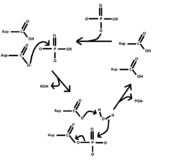User:Taranvir Rattu/Sandbox 1
From Proteopedia
Taranvir Rattu (Talk | contribs)
(New page: == LHPP == <Structure load='2X4D' size='350' frame='true' align='right' caption='Insert caption here' scene='Insert optional scene name here' /> == Function == Phospho'''l'''ysine Phospho'...)
Next diff →
Revision as of 01:58, 29 April 2020
Contents |
LHPP
|
Function
Phospholysine Phosphohistidine Inorganic Pyrophosphate Phosphatase (LHPP) is a 59.14 kDa homodimer phosphatase with an evolutionary presence that traces back to bacteria into modern humans. LHPP’s primary function is to catalyze the removal of phosphates from the nitrogen containing amino acids Lysine and Histidine, as well as the division of pyrophosphate into individual phosphates. As such, it belongs to the HAD-like hydrolase family. LHPP does this with the additional help from Mg2+ ions found in each subunit. For humans, expression is high in the brain, kidney, and liver tissues. Within the cell itself, LHPP is found to be a cytosolic and nuclear protein. Its metabolic involvement in the human body has been elucidated to be part of nucleobase synthesis and tumor suppression, however its concerted involvement is unknown.
Mechanism
HAD-like hydrolases have a unique characteristic about their mechanism, setting them apart from alkaline or tyrosine-specific hydrolases. Instead of utilizing a serine or cysteine as the nucleophile, HAD-like hydrolases use an aspartate residue. Additionally, another aspartate is present to aid in stabilization of the mechanism. As seen in figure 1, the aspartate residue performs nucleophilic attack on the phosphate, releasing the adjacent R-group. The R group is also protonated by the adjacent aspartic acid residue. The adjacent aspartic acid residue then functions as a base on an incoming H2O molecule, converting it into a hydroxide nucleophile and regenerating the aspartic acid. The hydroxide performs nucleophilic attack on the phosphate, liberating and renewing the enzyme.
Structural Description
LHPP is a homodimer with cyclic C2 symmetry. There are 4 total domains within the enzyme, all primarily consisting of Rossmainoid folds forming a 3 stacked a/B sandwich, with a pattern of repeating 𝜷-𝜶 units. The core catalytic domain contains 5 B-strands with a spacial alignment of ‘54123’. With HAD-like hydrolases, the Rossman fold helps form distinct conformations states that contribute to its substrate specificity and active site availability, which are known as squiggle and flap elements.
Pathology
LHPP has not been well characterized in human pathology. It has been identified as a tumor suppressor in hepatic tissue in mice and low expression was correlated with hepatocellular carcinoma. Oddly enough, it has also been associated with mental health as well, such as Major Depressive Disorder, risky sexual behaviors, and alcohol dependence. Further research is still required on these subjects.

